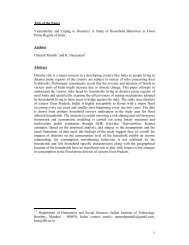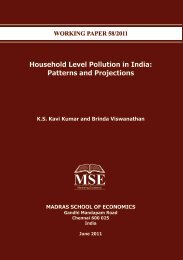Discount Rate for Health Benefits and the Value of Life in India
Discount Rate for Health Benefits and the Value of Life in India
Discount Rate for Health Benefits and the Value of Life in India
Create successful ePaper yourself
Turn your PDF publications into a flip-book with our unique Google optimized e-Paper software.
appears to be a Samuelson-Bergson type <strong>of</strong> social welfare function: SW<br />
= f (U1, U2, …….Un), where SW is social welfare that depends upon<br />
<strong>the</strong>(<strong>in</strong>come related) utilities <strong>of</strong> <strong>in</strong>dividuals <strong>in</strong> <strong>the</strong> society, U. The change <strong>in</strong><br />
<strong>the</strong> society welfare is affected by <strong>the</strong> changes <strong>in</strong> <strong>in</strong>dividuals’ <strong>in</strong>come, Yi.<br />
The total utility function <strong>in</strong>creases as <strong>in</strong>come/consumption <strong>in</strong>creases<br />
while marg<strong>in</strong>al utility function decreases as <strong>in</strong>come/consumption<br />
<strong>in</strong>creases with constant elasticity. This dim<strong>in</strong>ish<strong>in</strong>g marg<strong>in</strong>al utility (DMU)<br />
<strong>of</strong> <strong>in</strong>come/consumption is <strong>the</strong> ma<strong>in</strong> reason <strong>for</strong> giv<strong>in</strong>g greater weigh to<br />
present consumption opposed to future consumption (Kula, 2004).<br />
Many models, developed to compute <strong>the</strong> social rate <strong>of</strong> time<br />
preference (S) <strong>in</strong>clud<strong>in</strong>g <strong>the</strong> one employed by Sharma et al., (1991) <strong>for</strong><br />
<strong>India</strong>, conta<strong>in</strong> <strong>the</strong> notion <strong>of</strong> DMU. Based upon this, <strong>the</strong> l<strong>in</strong>ear <strong>for</strong>mula <strong>for</strong><br />
S can be expressed as: S = m + εg, where m is a pure time discount<br />
rate, g is <strong>the</strong> growth rate <strong>of</strong> per capita real consumption <strong>and</strong> ε is <strong>the</strong><br />
negative <strong>of</strong> <strong>the</strong> elasticity <strong>of</strong> marg<strong>in</strong>al utility <strong>of</strong> consumption (see<br />
Mark<strong>and</strong>ya <strong>and</strong> Pearce, 1988 <strong>for</strong> a lucid derivation <strong>of</strong> S). If <strong>the</strong><br />
consumption grows, S will rise above <strong>the</strong> private discount rate, m. With<br />
no growth <strong>in</strong> per capita consumption, S = m. S can be positive even if<br />
<strong>the</strong> consumption is fall<strong>in</strong>g as long as m > |εg|.<br />
The opportunity cost <strong>of</strong> capital or social return on <strong>in</strong>vestment (ρ)<br />
can be obta<strong>in</strong>ed by look<strong>in</strong>g at <strong>the</strong> rate <strong>of</strong> return on <strong>the</strong> best <strong>in</strong>vestment<br />
<strong>of</strong> similar risk that is displaced as a result <strong>of</strong> undertak<strong>in</strong>g <strong>the</strong> project <strong>in</strong><br />
question. It requires an <strong>in</strong>vestment to yield a return at least as high as<br />
that on <strong>the</strong> alternative use <strong>of</strong> funds. This is <strong>the</strong> basic rationale <strong>for</strong> a<br />
discount based on <strong>the</strong> opportunity cost. Due to a shortage <strong>of</strong> capital,<br />
such rates are usually very high <strong>in</strong> develop<strong>in</strong>g countries. 1<br />
1 A criticism leveled aga<strong>in</strong>st <strong>the</strong> opportunity cost discount<strong>in</strong>g is that it implies a re<strong>in</strong>vestment <strong>of</strong><br />
benefits at <strong>the</strong> opportunity cost rate <strong>and</strong> quite <strong>of</strong>ten this is <strong>in</strong>valid. There<strong>for</strong>e, many past studies<br />
have applied <strong>the</strong> weighted discount rate procedure as advocated <strong>in</strong> Margl<strong>in</strong> (1967).<br />
3



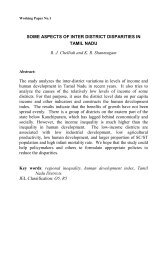

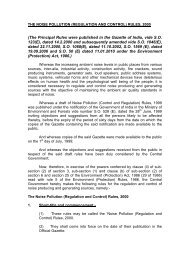
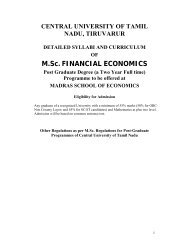
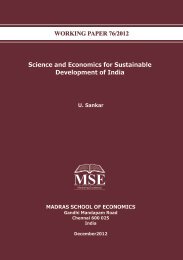
![Curriculum Vitae [pdf] - Madras School of Economics](https://img.yumpu.com/49878970/1/190x245/curriculum-vitae-pdf-madras-school-of-economics.jpg?quality=85)
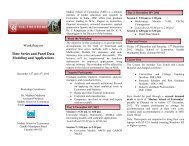
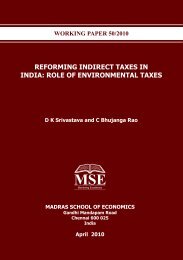
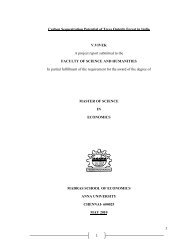
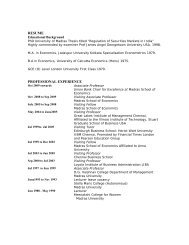
![Curriculum Vitae [pdf] - Madras School of Economics](https://img.yumpu.com/48715201/1/184x260/curriculum-vitae-pdf-madras-school-of-economics.jpg?quality=85)
